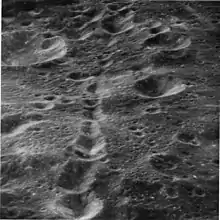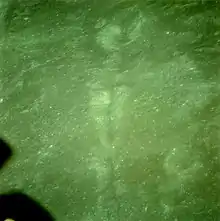Gregory (lunar crater)
Gregory is a lunar impact crater on the far side of the Moon. It is located to the southeast of the crater Ibn Firnas, and north-northeast of Bečvář. About one crater diameter to the north is the smaller Morozov.
 Apollo 16 Mapping Camera image | |
| Coordinates | 2.2°N 127.2°E |
|---|---|
| Diameter | 64 km |
| Colongitude | 234° at sunrise |
| Eponym | James Gregory |


This is a worn and eroded crater formation. The northern rim is degraded due to impacts. Attached to the exterior of the southwest is Gregory Q, a satellite crater about the same size as Gregory. Within the interior is the remains of a small crater rim along the northwestern inner wall. To the east of Gregory and leading away to the southeast is a crater chain designated Catena Gregory.[1]
The crater was named after 17th century Scottish astronomer and mathematician James Gregory by the IAU in 1970.[2] While Gregory itslef was unnumbered, its satellite crater Gregory Q was known as Crater 282 prior to naming in 2006.[3][4]
Satellite craters
By convention these features are identified on lunar maps by placing the letter on the side of the crater midpoint that is closest to Gregory.
| Gregory | Latitude | Longitude | Diameter |
|---|---|---|---|
| K | 0.4° S | 128.5° E | 26 km |
| Q | 0.6° N | 125.7° E | 68 km |
References
- Catena Gregory, Gazetteer of Planetary Nomenclature, International Astronomical Union (IAU) Working Group for Planetary System Nomenclature (WGPSN)
- Gregory, Gazetteer of Planetary Nomenclature, International Astronomical Union (IAU) Working Group for Planetary System Nomenclature (WGPSN)
- Lunar Farside Chart (LFC-1A)
- Gregory Q, Gazetteer of Planetary Nomenclature, International Astronomical Union (IAU) Working Group for Planetary System Nomenclature (WGPSN)
- Andersson, L. E.; Whitaker, E. A. (1982). NASA Catalogue of Lunar Nomenclature. NASA RP-1097.
- Bussey, B.; Spudis, P. (2004). The Clementine Atlas of the Moon. New York: Cambridge University Press. ISBN 978-0-521-81528-4.
- Cocks, Elijah E.; Cocks, Josiah C. (1995). Who's Who on the Moon: A Biographical Dictionary of Lunar Nomenclature. Tudor Publishers. ISBN 978-0-936389-27-1.
- McDowell, Jonathan (July 15, 2007). "Lunar Nomenclature". Jonathan's Space Report. Retrieved 2007-10-24.
- Menzel, D. H.; Minnaert, M.; Levin, B.; Dollfus, A.; Bell, B. (1971). "Report on Lunar Nomenclature by the Working Group of Commission 17 of the IAU". Space Science Reviews. 12 (2): 136–186. Bibcode:1971SSRv...12..136M. doi:10.1007/BF00171763. S2CID 122125855.
- Moore, Patrick (2001). On the Moon. Sterling Publishing Co. ISBN 978-0-304-35469-6.
- Price, Fred W. (1988). The Moon Observer's Handbook. Cambridge University Press. ISBN 978-0-521-33500-3.
- Rükl, Antonín (1990). Atlas of the Moon. Kalmbach Books. ISBN 978-0-913135-17-4.
- Webb, Rev. T. W. (1962). Celestial Objects for Common Telescopes (6th revised ed.). Dover. ISBN 978-0-486-20917-3.
- Whitaker, Ewen A. (1999). Mapping and Naming the Moon. Cambridge University Press. ISBN 978-0-521-62248-6.
- Wlasuk, Peter T. (2000). Observing the Moon. Springer. ISBN 978-1-85233-193-1.